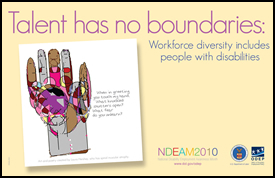 In 1945, Congress declared the first week in October “National Employ the Physically Handicapped Week.” In 1962, the word “physically” was removed in acknowledgment of individuals with all types of disabilities. In 1988, Congress expanded the week to a month and changed the name to “National Disability Employment Awareness Month” (NDEAM). This year, the Office of Disability Employment Policy (ODEP) has designated “Talent Has No Boundaries: Workforce Diversity Includes People with Disabilities” as the theme of NDEAM.
In 1945, Congress declared the first week in October “National Employ the Physically Handicapped Week.” In 1962, the word “physically” was removed in acknowledgment of individuals with all types of disabilities. In 1988, Congress expanded the week to a month and changed the name to “National Disability Employment Awareness Month” (NDEAM). This year, the Office of Disability Employment Policy (ODEP) has designated “Talent Has No Boundaries: Workforce Diversity Includes People with Disabilities” as the theme of NDEAM.
Disabled Workers Important to Economy
In a statement about NDEAM, President Barack Obama recognized the importance of integrating people with disabilities into the workplace: “As Americans, we understand employment and economic security are critical to fulfilling our hopes and aspirations. We also know we are stronger when our country and economy can benefit from the skills and talents of all our citizens. No individual in our nation should face unnecessary barriers to success, and no American with a disability should be limited in his or her desire to work.”
In her own statement about NDEAM, Department of Labor (DOL) Secretary Hilda L. Solis adds: “Across America, there are 54 million people with disabilities, and their talents enrich our communities every single day. Yet opening the door to opportunity for many of these workers remains a challenge. President Obama and I believe this reality undermines the true strength of our economy and our nation, and we are taking decisive steps to address the situation.”
New Laws and Regs
Obama didn’t wait until NDEAM to take action on those convictions. On July 26, he signed an Executive Order that requires the federal government’s executive departments and agencies to create goals and action plans for hiring more people with disabilities as well as improving retention and return to work.
Under the guidance of Solis, ODEP has been working with the DOL’s Office of Federal Contract Compliance Programs to strengthen the affirmative action requirements of the regulations implementing Section 503 of the Rehabilitation Act of 1973. The goal is to make federal contractors, who are responsible for 25% of the available jobs in America, accountable for benchmarks for hiring qualified workers with disabilities.
“Until now, it was enough for employers to make attempts to hire qualified workers with disabilities, even if their efforts never resulted in actual job offers,” Solis said in a statement.
In his NDEAM statement, Obama notes that “technology has changed the way we work.” On October 8, he signed the Twenty-First Century Communications and Video Accessibility Act of 2010 into law. In his remarks after he signed the Act, he commented that it “sets new standards so that Americans with disabilities can take advantage of the technology our economy depends on. And that’s especially important in today’s economy, when every worker needs the necessary skills to compete for the jobs of the future.”
New Programs
According to Solis, “Increasing employment for people with disabilities is contingent on increasing more accurate and positive portrayals of people with disabilities in the media. With that in mind, ODEP created two campaigns: “Lights! Camera! Access!” and the “Campaign for Disability Employment.”
Lights! Camera! Access! is focused on improving images and increasing employment opportunities for people with disabilities in front of and behind the camera. The Campaign for Disability Employment uses public service announcements to expand awareness and interest in employing the disabled by showcasing real-life stories of contributions that people with disabilities make to their workplaces.
Want to Learn More?
Want more guidance on hiring and working with the disabled? The ODEP’s website offers several tools for employers, including an online return-to-work toolkit and a series of briefs “designed to succinctly increase awareness of ideas, services, and products that enhance employment opportunities for all workers, including workers with disabilities.”
